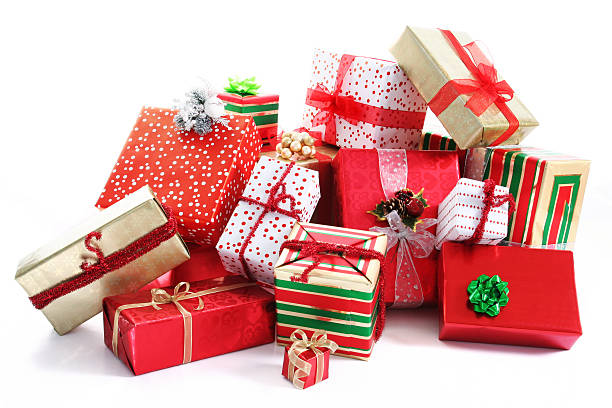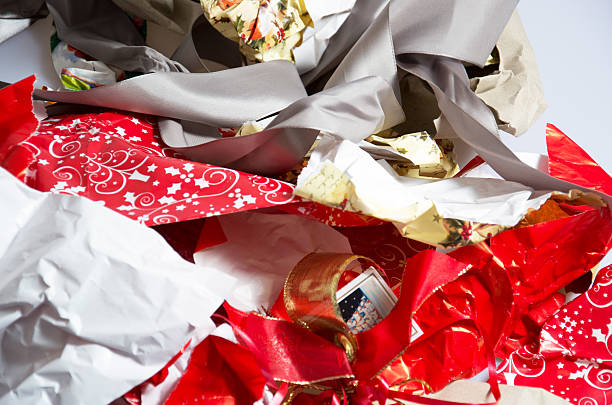Earth911 estimates the U.S. produces approximately 4.6 million pounds of wrapping paper each year. Of that, landfills receive half. The number of trees required to manufacture all that gift wrap equates to between 30 and 50 million trees annually.
These stats illuminate the fact that consumption of single-use wrapping paper starts and ends with problems for the environment. From harvesting trees to balls of discarded gift wrap, the entire supply chain is bad for the planet.
Discover: Gift Wrap Solutions That Are Eco-Friendly
Water and Energy Required to Make Wrapping Paper

As with most single-use products, the resources required to produce wrapping paper overwhelmingly outweigh the lifespan of the product. Take water, for example. Throughout the process, water supports the growth of trees, conversion of trees into pulp, and the transformation of pulp into the paper products we use. Therefore, cutting back on wrapping paper directly leads to water conservation.
Similarly, we consume energy at every phase of the paper supply chain. We rely on fossil fuels to power everything from the logging equipment to the machines in the paper plant. Then we have to consider the energy used during manufacturing, transport, storage, and even on the store shelves. Post-consumer waste further requires transport to recycling centers or the landfill. From there, more energy burns to recycle, bury, or incinerate gift wrap at the end of the life cycle. All for the fleeting moment when someone opens a gift.
Fortunately, like many industries, paper manufacturers are cleaning up production by endlessly recycling water within the plants. They also reduce the harvest of virgin materials by relying on recycled paper when possible. However, even with these efforts we harvest 200 million trees every day. Every Day. Stripping the land of trees reduces carbon suppression, soil stability, and natural temperature control, among other environmental issues.
Since the majority of wrapping paper isn’t recycled, it means all those resources quickly arrive at the dump.
Chemicals and Dyes
Enhancing the environmental problems with wrapping paper, the added chemicals are bad for the air, water, soil, and humans that come into contact with them. Of course, not all paper production is toxic to the environment, but a good share of it includes fillers, retention aids, sizing agents, wet strength agents, dry strength agents, defoamers, dyes and pigments. None of that screams, “environmentally friendly”.
The best case scenario would be a conscientious manufacturing plant that relies only on natural ingredients in harmony with nature. But let’s be real here, that’s not the norm and whatever chemicals we weave into the paper we buy can’t hide from Mother Earth. As soon as that product begins to burn or degrade, those less-than-friendly additives leach directly into the soil, mix into the water supply, and evaporate into the air.
The Problems With Recycling Wrapping Paper

On the optimistic side of the discussion, estimates state we do recycle around half of the wrapping paper sold. That means it’s used in the next generation of paper products. While recycling wrapping paper means we use fewer virgin materials (trees) for the next batch, it’s still a very short life cycle from tree to gift wrap and back into paper.
On the other side of the equation, we have to recognize that even a 50% recycling rate means we’re still chopping down 15-25 million trees for single use wrapping paper annually, and then promptly sending them to the dump. Next to reducing (or eliminating) consumption, our next best course of action is recycling, so why is the rate so low?
The first reason is that some municipal services don’t allow curbside recycling of gift wrap. It’s shocking, actually, how undeveloped recycling services are in many areas of the country, especially in rural zones. Most organized cities, however, do include wrapping paper in curbside service as long as it’s made from 100% paper.
This, however, leads to problem number two, which is that wrapping paper is often unrecyclable because it’s made from a mixture of materials. That fun glitter paper includes bits of metal. Similarly, that sparkle and shine we find so appealing stems from the application of a plastic coating. Because mixed materials can’t be recycled, that glitzy and glossy paper needs to go straight into the trash.
Can I Burn Wrapping Paper?
Sometimes yes, sometimes no. Mirroring the problems with recycling wrapping paper, you have to be selective about the types of paper you toss into the fire. You can burn all-paper wrapping paper and use it as an effective fire starter. However, you should not burn wrapping paper that contains dyes, chemicals, metal, or plastic as it will release toxins into the air.
To Recycle or Not to Recycle
People often don’t understand what types of wrapping paper can be recycled. Here’s a quick test: if you crumple it up and it stays in that position, it is likely all paper and can go into the recycling. However, if the crumpled ball springs back, throw it into the trash or give used wrapping paper a second life.
The Bottom Line
Now that you’re aware of the many ways wrapping paper is bad for the environment, take a step towards waste-free gift wrapping with Gift Wrap Solutions That Are Eco-Friendly instead. It’s easy to do and you’ll save money in the process. Plus, your gifts will be unique and memorable.




Recent Comments